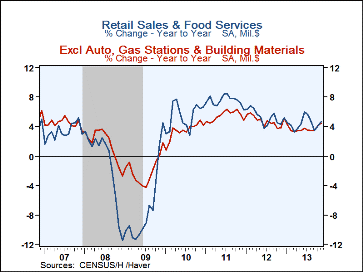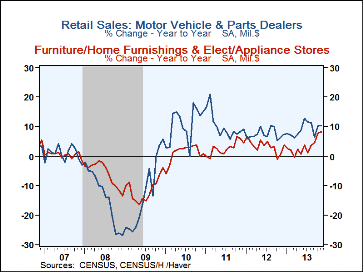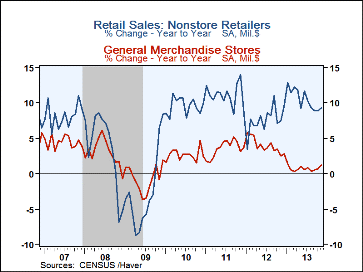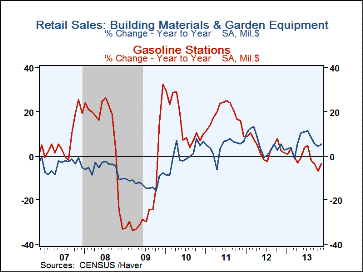 Global| Dec 12 2013
Global| Dec 12 2013U.S. Retail Sales Gain is Strongest Since June
by:Tom Moeller
|in:Economy in Brief
Summary
Retail sales gained strength during November as new cars were bought and as consumers dined out more. Retail spending firmed 0.7% (4.7% y/y) following a 0.6% October advance, revised up from 0.4%. A 0.6% rise had been expected in the [...]
Retail sales gained strength during November as new cars were bought and as consumers dined out more. Retail spending firmed 0.7% (4.7% y/y) following a 0.6% October advance, revised up from 0.4%. A 0.6% rise had been expected in the Action Economics Forecast Survey. Sales of motor vehicles & parts led the increase with a 1.8% gain (10.2% y/y). Sales at food service & drinking places weren't far behind and posted a 1.3% advance (5.2% y/y). Nonauto retail sales rose 0.6% (4.4% y/y) after a 0.8% October rise. A 0.2% improvement had been expected.
Sales of nonstore retailers jumped 2.2% (9.4% y/y) and added to the strong gains of the prior two months. Building materials sales followed with a 1.8% advance (5.3% y/y) which recouped a 1.5% October drop. Furniture & electronics/appliance store sales jumped 1.1% (8.2% y/y) following a 2.2% October surge.
To the weak side were general merchandise store sales which ticked 0.1% higher (1.2% y/y) following a 0.3% advance. Clothing & accessory stores sales were off 0.2% (+4.1 y/y) after a 2.6% October spike. Also lower were food & beverage store sales by 0.1% for a second month (+2.6% y/y). Lower prices depressed sales at gasoline service stations by 1.1% (3.3% y/y), down for the third month in the last four.
The retail sales figures are available in Haver's USECON database. The Action Economics figures are in the AS1REPNAdatabase.
| Retail Spending (%) | Nov | Oct | Sep | Nov Y/Y | 2012 | 2011 | 2010 |
|---|---|---|---|---|---|---|---|
| Total Retail Sales & Food Services | 0.7 | 0.6 | 0.1 | 4.7 | 5.3 | 7.5 | 5.5 |
| Excluding Autos | 0.4 | 0.5 | 0.4 | 3.5 | 4.8 | 7.0 | 4.5 |
| Non-Auto Less Gasoline & Building Supplies | 0.6 | 0.8 | 0.4 | 4.4 | 4.8 | 5.5 | 3.5 |
| Retail Sales | 0.6 | 0.5 | 0.0 | 4.6 | 5.0 | 7.7 | 5.8 |
| Motor Vehicle & Parts | 1.8 | 1.1 | -1.1 | 12.2 | 7.5 | 10.1 | 10.6 |
| Retail Less Autos | 0.3 | 0.3 | 0.4 | 3.2 | 4.4 | 7.1 | 4.6 |
| Gasoline Stations | -1.1 | -0.4 | 0.2 | -3.3 | 4.0 | 18.4 | 14.6 |
| Food Service & Drinking Places Sales | 1.3 | 1.4 | 0.6 | 5.2 | 7.2 | 6.0 | 3.2 |
Tom Moeller
AuthorMore in Author Profile »Prior to joining Haver Analytics in 2000, Mr. Moeller worked as the Economist at Chancellor Capital Management from 1985 to 1999. There, he developed comprehensive economic forecasts and interpreted economic data for equity and fixed income portfolio managers. Also at Chancellor, Mr. Moeller worked as an equity analyst and was responsible for researching and rating companies in the economically sensitive automobile and housing industries for investment in Chancellor’s equity portfolio. Prior to joining Chancellor, Mr. Moeller was an Economist at Citibank from 1979 to 1984. He also analyzed pricing behavior in the metals industry for the Council on Wage and Price Stability in Washington, D.C. In 1999, Mr. Moeller received the award for most accurate forecast from the Forecasters' Club of New York. From 1990 to 1992 he was President of the New York Association for Business Economists. Mr. Moeller earned an M.B.A. in Finance from Fordham University, where he graduated in 1987. He holds a Bachelor of Arts in Economics from George Washington University.










